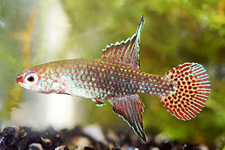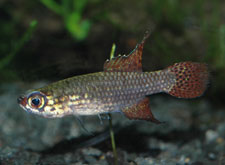History
Campellolebias intermedius is only known by the description so far. The species was found by De Luca A.C. et al. in 2002 on Oktober 27.
The place of discovery is situated 6 km west of Juquia in the rio Juquia drainage, rio Ribeira de Iguape basin, Estado Sao Paulo, southeastern Brasil.
Reproduction
Breeding Campellolebias is for hobbyists with some experience, and results vary. The species lives in primary forest, does not like too much light, and should be kept in low pH values as low as 5 to 5.5 pH. Dark brown water and shelter for the females that are in the breeding setup with one male-only. Males can be very aggressive to other males but to females also. Eggs are fertilized internally using a gonopodium, which is characteristic of this genus's four known species. As natural annuals, they live in temporary stagnant water near rivers.
After some days, the female drops their eggs freely just above the bottom. These eggs need about 8 - 12 weeks to develop at a storage temperature of about 24 C.. Water temperatures for the fishes should be not too high and can be as low as 18 C. and as high as 26 C. (the latter for short periods).
Eggs should be stored in cooler temperatures, 18-24C. The species are typical forest-dwellers, and eggs should not be stored in full light. The eggs have a hirsute ('hairy') membrane easily recognized, formed by numerous tiny non-adhesive filaments. Minute particles thereby can attach, and eggs become almost invisible to predators (and for us, as a breeder!).
High temperatures are shortening their lifespan that generally can be one year or less. However, growth is rapid, and reproduction starts at two months from birth if fed regularly with life artemia and other small life food. Dry food or frozen food is hardly accepted. Eggs are colored deep dark brown, have short spine-like non- adhesive filaments on their membranes (Chorion), and are extremely hard to find in the brown peat.
Herve Gonin, France, reported his breeding experience about this species to us. He wrote: Camp. intermedius is an easy fish to keep once adult, but the fry is fragile and does not like the change in water parameters. Incubation is 2.5 months at 25/26 °C. , sex ratio is quite good. Thank you Herve.
Variations
Map
Meristics
Max. size 4.0 cm.
Dorsal 16.0,
Anal 15.5,
D/A -3.0,
LL scale count (average)26.5
Pre- dorsal length to % SL – 56.4 %
Depth to % SL – 27.9 %
Literature


